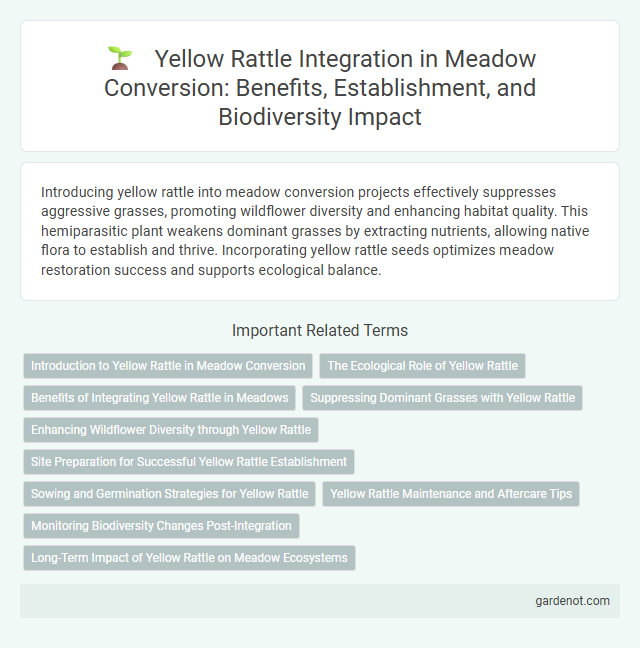Introducing yellow rattle into meadow conversion projects effectively suppresses aggressive grasses, promoting wildflower diversity and enhancing habitat quality. This hemiparasitic plant weakens dominant grasses by extracting nutrients, allowing native flora to establish and thrive. Incorporating yellow rattle seeds optimizes meadow restoration success and supports ecological balance.
Introduction to Yellow Rattle in Meadow Conversion
Yellow rattle (Rhinanthus minor) is a semi-parasitic plant crucial for successful meadow conversion, as it suppresses dominant grasses and promotes wildflower diversity. Introducing yellow rattle seeds into grass-dominated fields increases biodiversity by weakening vigorous grasses, allowing native wildflowers to establish and thrive. Effective yellow rattle establishment requires well-prepared, low-fertility soil and strategic sowing in early autumn to ensure optimal growth and meadow development.
The Ecological Role of Yellow Rattle
Yellow rattle (Rhinanthus minor) plays a crucial ecological role in meadow conversion by acting as a semi-parasitic plant that suppresses vigorous grasses, allowing diverse wildflowers to establish and thrive. Its parasitic relationship reduces dominant grass competition, enhancing biodiversity and creating balanced meadow ecosystems. This influence significantly increases habitat heterogeneity and supports pollinator populations, contributing to healthier, more resilient meadow environments.
Benefits of Integrating Yellow Rattle in Meadows
Yellow rattle (Rhinanthus minor) acts as a natural regulator by hemiparasitizing dominant grasses, reducing their vigor and allowing wildflowers to establish, thereby enhancing meadow biodiversity. Its introduction promotes increased floral diversity and supports a wider range of pollinators, essential for ecosystem resilience. Integrating yellow rattle leads to improved grassland structure and fosters a balanced, species-rich meadow environment.
Suppressing Dominant Grasses with Yellow Rattle
Yellow rattle (Rhinanthus minor) effectively suppresses dominant grasses by parasitizing their roots, which reduces grass vigor and growth, allowing wildflowers to establish and thrive. This hemiparasitic plant can decrease grass biomass by up to 50%, creating more open space and resources for diverse meadow species. Introducing yellow rattle is a proven strategy to enhance biodiversity and restore species-rich grassland habitats.
Enhancing Wildflower Diversity through Yellow Rattle
Yellow rattle (Rhinanthus minor) is a hemiparasitic plant that suppresses vigorous grasses by extracting nutrients, creating space and light for wildflowers to establish in meadow conversions. Introducing yellow rattle effectively enhances wildflower diversity by reducing grass dominance, leading to richer plant communities and improved habitat for pollinators. Research demonstrates that incorporating yellow rattle can increase wildflower species richness by up to 30% within a few seasons.
Site Preparation for Successful Yellow Rattle Establishment
Effective site preparation is crucial for successful Yellow Rattle establishment in meadow conversion projects. This involves reducing existing vegetation by methods such as mowing, scarification, or herbicide application to minimize competition and expose bare soil. Optimal soil conditions and light availability directly enhance Yellow Rattle seed germination and growth, ensuring better integration into the target meadow ecosystem.
Sowing and Germination Strategies for Yellow Rattle
Yellow rattle seeds require a cold stratification period to break dormancy, making autumn sowing optimal for successful germination. Proper soil preparation, including light disturbance and removal of competitive vegetation, enhances seed-soil contact and promotes seedling establishment. Monitoring moisture levels during early growth stages ensures better germination rates and supports the effective establishment of yellow rattle in meadow conversion projects.
Yellow Rattle Maintenance and Aftercare Tips
Yellow rattle requires regular monitoring to prevent vigorous grass growth from outcompeting it, ensuring successful establishment in meadow conversion projects. Seasonal mowing after seed set helps disperse yellow rattle seeds and controls grasses, promoting biodiversity. Maintaining light soil conditions and avoiding excessive fertilization supports yellow rattle's semi-parasitic growth habit essential for sustainable meadow habitats.
Monitoring Biodiversity Changes Post-Integration
Yellow rattle (Rhinanthus minor) introduction plays a crucial role in meadow conversion by suppressing dominant grasses and enhancing floral diversity. Monitoring biodiversity changes post-integration involves systematic surveys of plant species richness, abundance, and composition to assess ecosystem improvements. Long-term data collection reveals positive trends in pollinator populations and soil health, confirming the effectiveness of yellow rattle in restoring meadow biodiversity.
Long-Term Impact of Yellow Rattle on Meadow Ecosystems
Yellow rattle (Rhinanthus minor) significantly enhances meadow biodiversity by suppressing dominant grasses, allowing wildflowers to flourish and increasing floral richness over time. Its parasitic nature reduces grass vigor, leading to sustained changes in community composition that support pollinators and other invertebrates. Long-term presence of yellow rattle promotes habitat heterogeneity and ecological resilience, critical for meadow ecosystem restoration and conservation.
Yellow rattle introduction Infographic

 gardenot.com
gardenot.com